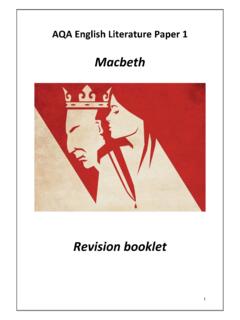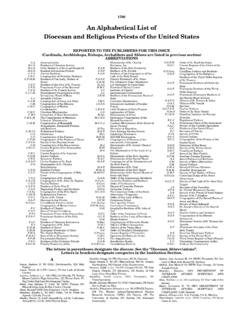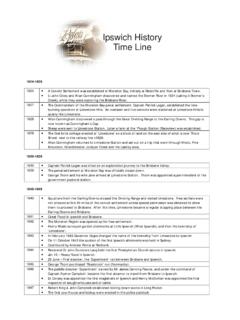Transcription of Macbeth - Bishop Fox's School
1 1 AQA English Literature Paper 1 Macbeth Revision booklet 2 REMINDER In the exam, you will be presented with a short extract from the play. There will only be ONE question on Macbeth you MUST answer it! The question will ask you to focus on the extract (examiners expect to see close language analysis) and then relate it to elsewhere in the play, so you can show your understanding of the whole play. You are advised to spend 45 minutes writing your response to Macbeth and then 5 minutes carefully proof-reading it for SPAG accuracy! (You then spend the next 50 minutes in this exam writing your response to the question on Dickens novel, A Christmas Carol.)
2 SPAG is marked for your Macbeth answer so spend 5 minutes checking and correcting any mistakes you might have made when writing against the clock! 3 Macbeth : a chain of events 4 Macbeth : Some important historical, social and cultural contexts Up until Henry VIII chose to divorce his first wife, Catherine of Aragon, England was a country where people practised the Roman catholic faith, under the leadership of the Pope in Rome. Henry wanted to divorce Catherine of Aragon for several reasons: mainly, he had not fallen in love with her; in fact, she was supposed to marry Henry s brother, Arthur, but he died.
3 Put simply, when Henry became king of England, he appealed to the Pope in Rome to annul his marriage to Catherine but the Pope refused, saying that marriage was a lifelong contract agreed in church in the presence of God. Henry decided to divorce himself and the English kingdom from the catholic church. He established the Church of England and, as the reigning monarch, installed himself as the head of the Church of England. He set about dismantling the abbeys throughout his kingdom, seizing all the precious gold and silver, jewel-encrusted ornaments for himself and his new branch of Christianity became known as Protestantism (because of the protests made to Rome regarding his divorce).
4 This led to very deep divisions between people throughout England. In your own lifetime, a comparable divide is the recent Brexit campaign and result, which is still on everyone s lips and which remains the cause of some social and political tension, unrest, and disagreement in our society. The unrest caused by Henry s decision to split from the catholic church continued long after his own lifetime. When he died, his daughter became Queen Elizabeth I and, like her father, she was a Protestant. During her lifetime there were several assassination attempts and plots to overthrow her by Catholics who wished to return England to the supreme leadership of the Pope in Rome.
5 Some of those plots were led by Elizabeth s own catholic cousin, Mary Queen of Scots. Elizabeth grew tired of Mary s plots and eventually agreed to her execution. Following Mary s beheading, her son James became James VI of Scotland and when the childless Elizabeth I grew old and died, James seized the throne of England and became the first King James of England. King James I and the Gunpowder Plot Before ascending to the throne of England, James has begun to build a trusting relationship with Elizabeth I, although English Catholics hoped he would show them more tolerance than she had. Despite this, James was as intolerant of Catholics as Elizabeth and consequently, catholic plots to assassinate King James formed.
6 The most famous of these assassination attempts is known as The Gunpowder Plot of 1605. Interestingly, to commemorate King James lucky escape a medal was commissioned showing a snake concealed by flowers. In the play, when plotting the regicide of King Duncan, Lady Macbeth tells her husband: Look like the innocent flower/But be the serpent under t. Above: the medal issued to commemorate the failed assassination of King James I 5 Also, one of the men involved in the Gunpowder Plot, Everard Digby, had been a close friend of King James and in the play is probably mirrored by the treasonous thane of Cawdor. No wonder King Duncan says of the thane of Cawdor: There s no art/To find the mind s construction in the was a gentleman on whom I built/An absolute trust.
7 King James, sitting in the audience watching the very first performance of Macbeth , knew only too well the sense of betrayal expressed by King Duncan here. Lastly, a major theme in the play is that of equivocation, which means to tell deliberately misleading half-truths. The witches equivocate in the play because they inform Macbeth that No man born of a woman can harm him, leading him to imagine himself to be invincible and that he will be unbeaten until Birnam Wood (a forest) moves towards his castle. Importantly, Macbeth s noble friend, Banquo, does warn Macbeth about the witches and their prophecies when he advises: Oftentimes, to win us to our harm the instruments of darkness tells us truths, win us with honest trifles, to betray s in deepest consequence.
8 So, in what way might the theme of equivocation be connected to historical, social and cultural contexts? Well, in 1606 a catholic priest named Henry Garnet was accused of treason, for the role he played in the Gunpowder Plot. When he was put on trial, he was found guilty of committing a crime called perjury (giving false evidence to the court) but he claimed the right to equivocate (to tell deliberately misleading half-truths) in self-defence. So, not only was equivocation a burning issue in England when Shakespeare was writing the play but events which unfold within it perhaps also reflects his personal view of it: namely, people who equivocate are not to be trusted whether they are witches in 11th century Scotland or catholic priests in 17th century England.
9 King James I and Witchcraft Belief in witches and witchcraft was widespread across Europe during the 16 and 17th centuries and during the reign of Elizabeth I, persecution of people accused of witchcraft reached terrifying proportions. Hundreds of people mostly women were tortured, convicted and then executed for this crime between 1560 and 1603 in England. People genuinely believed that witches possessed diabolical powers: it was believed that witches could fly, sail in sieves, create night during the day (we call this a solar eclipse today), cause fogs and storms, disease and even a person or an animal to die because of a curse.
10 A witches curse was believed to have the power to cause infertility or to induce nightmares. Witches were also believed to be able to conjure spirits by concocting a horrible brew, typically made using animal entrails and other nauseating ingredients. When Lady Macbeth conjures evil spirits, the Jacobean audience watching the play would have identified her as a witch inviting spirits to take possession of her body. They would have been horrified that she so willingly condemns her Christian soul to Hell because of her lust for power. In 1604 when Shakespeare was writing the play, an Act of Parliament decreed that the punishment for those convicted of witchcraft would be execution.








